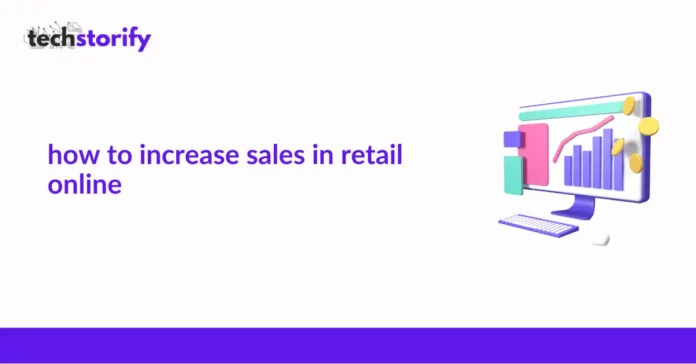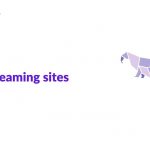Increasing online sales is the primary objective of any organization, no matter what size it is. With many options available to consumers at the click of a button, retailers should implement effective strategies to stand out from the competition and drive revenue growth. Fortunately, there are thousands of techniques to increase your online sales, many of which you can implement within minutes.
If you’re wondering how to increase sales in retail, we got a solution for you. Continue reading to learn how to optimize your business and increase sales.
Contents
- Why Can’t I Increase Sales?
- General Strategies to Increase Sales
- 1. Understand your target audience
- Personalized messaging
- Product development and innovation
- User experience optimization
- Targeted advertising
- Effective customer communication
- 2. Use analytics to understand how customers find your product or service
- 3. Identify what makes your service or product unique
- 4. Offer multiple payment methods
- 5. Simplify the checkout process
- Ten Tips to Increase Conversion Rate
- Conclusion
Why Can’t I Increase Sales?
Increasing online sales can be challenging due to various factors, including:
- Intense competition. The online marketplace is highly competitive, with numerous businesses competing for customers’ attention and purchases. Standing out from the crowd and capturing customers’ interest can be difficult.
- Trust and credibility. Building trust and credibility with online shoppers can be challenging, particularly for new or less-known brands. Customers may hesitate to make purchases from unfamiliar websites due to concerns about security, product quality, or customer service.
- Limited tangibility. Unlike in physical stores, online shoppers cannot physically touch, feel, or try products online before purchasing. This lack of tangibility can create barriers to conversion as customers may need clarification about the product’s suitability or quality.
- Customer acquisition costs. Acquiring new customers online often involves marketing and advertising expenses, which can be costly. Competing for digital ad space, optimizing SEO, and targeting the right audience can require significant investments.
- Conversion rate optimization. Converting website visitors into paying customers can take time and effort. Factors such as website design, user experience, checkout process, and product presentation all impact conversion rates. Identifying and addressing barriers to conversion requires continuous analysis and optimization.
- Evolving consumer behavior. Online shopping trends and consumer behavior constantly evolve, making it crucial for businesses to stay updated and adapt their strategies accordingly. Keeping up with changing customer preferences and expectations can be a complex and ongoing process.
- Technical challenges. Maintaining a functional and user-friendly online store requires specialized expertise. Website maintenance, server uptime, security measures, and ensuring compatibility across devices and browsers can pose challenges for businesses without dedicated technical resources.
- Fulfillment and logistics. Managing inventory, order fulfillment, and shipping logistics is crucial for online businesses. Delays or issues in product delivery can negatively impact customer satisfaction and sales.
- Customer experience and support. Providing excellent customer support and promptly addressing inquiries or issues can be challenging online. Building strong customer relationships and delivering exceptional service requires effective communication channels and dedicated resources.
- Changing marketing landscape. Digital marketing strategies and platforms constantly evolve, requiring businesses to stay informed of new trends and tactics. Keeping up with algorithm updates, optimizing social media presence, and adapting to changing advertising channels can pose difficulties.
General Strategies to Increase Sales
If you want to enhance your sales, there are a few things you should do. First, you should determine your target audience and guarantee they can quickly access your product or service.
1. Understand your target audience
Understanding the target audience is crucial for increasing online sales, as it allows businesses to tailor their marketing strategies, products, and user experiences to meet their customers’ specific needs and preferences. Here’s how understanding the target audience can help boost online sales:
Personalized messaging
By understanding your target audience’s demographics, interests, and pain points. This increases the relevance and resonance of your marketing campaigns, making it more likely for customers to engage and convert.
Product development and innovation
Knowing your target audience’s preferences and desires helps you develop products or services that meet their needs. Creating solutions that directly address their pain points can increase customer satisfaction and loyalty, leading to higher sales.
User experience optimization
Understanding your target audience allows you to optimize your website, app, or online platform to provide a seamless and tailored user experience. You can optimize the layout, navigation, and content to increase engagement and conversions by identifying user preferences, browsing habits, and preferences.
Targeted advertising
With a clear understanding of your target audience, you can optimize your advertising efforts by targeting the right demographics, interests, and channels. This increases the likelihood of reaching potential customers more likely to be interested in your products or services, resulting in higher conversion rates.
Effective customer communication
Understanding your target audience helps you communicate with them effectively. You can use their preferred communication channels, language, and tone to engage with them meaningfully. This builds trust, strengthens relationships, and encourages repeat purchases.
2. Use analytics to understand how customers find your product or service
Business analytics provides valuable insights into customer acquisition by tracking and analyzing data related to customer journeys, traffic sources, keywords, and conversion funnels. By leveraging analytics effectively, businesses can optimize their marketing efforts, improve customer acquisition, and drive sustainable growth.
- Analytics provides insights into customers’ keywords and search terms to find products or services. This helps businesses optimize their website content and SEO strategies to rank higher in relevant search results.
- It also provides quantitative data that informs strategic decision-making. By understanding how customers find products or services, businesses can allocate resources effectively, invest in the most profitable channels, and refine their marketing strategies.
3. Identify what makes your service or product unique
Branding significantly increases online sales by building trust, credibility, and recognition among customers. A strong brand can positively impact customer perception and influence their purchasing decisions.
One real-life example is Nike, a global athletic footwear and apparel leader. Nike’s strong branding, encompassing its iconic logo, the memorable slogan “Just Do It” and consistent messaging, has helped them establish a solid emotional connection with customers.
According to a report by Forbes, Nike’s brand value reached $3.1 billion in 2022, making it the most valuable apparel brand globally. This demonstrates how effective branding can increase online sales by creating a loyal customer base and influencing consumer behavior.
4. Offer multiple payment methods
By providing various payment options, businesses cater to the preferences and needs of different customers. Some customers prefer using credit cards, while others prefer digital wallets or alternative payment methods like PayPal or Apple Pay. Offering multiple options ensures that customers can choose the most comfortable way, increasing convenience and accessibility.
Secondly, online businesses targeting global customers can benefit from offering localized payment options. International customers may have preferred popular payment methods in their respective regions. By accommodating these preferences, businesses can expand their customer base and tap into new markets.
Finally, providing multiple payment options has been shown to increase conversion rates. According to the Baymard Institute, the average cart abandonment rate is 69.99%. This is based on an average of 48 shopping cart abandonment tests, with results ranging from 56% to 81%. The reason for this is a lack of preferred payment options. By offering customers’ preferred payment methods, businesses can reduce cart abandonment rates and improve overall conversion rates.
5. Simplify the checkout process
Simplifying the checkout process can increase online sales and boost conversion by reducing friction and eliminating obstacles that deter customers from completing their purchases. A streamlined and intuitive checkout process minimizes the number of steps, reduces form fields, and offers guest checkout options.
This improves user experience, increases convenience, and encourages customers to finalize their transactions, resulting in higher conversion rates and improved online sales.
Ten Tips to Increase Conversion Rate
- Optimize website speed and performance. Ensure that your website loads quickly and functions smoothly across different devices. A slow-loading site can lead to a high bounce rate and potential customer loss.
- Implement clear and compelling call-to-actions (CTAs). Use persuasive and action-oriented CTAs that communicate what action visitors want to take. Make them prominent and strategically placed throughout your website.
- Simplify the checkout process. Streamline the checkout process to minimize friction and increase conversion rates. Offer guest checkout options, eliminate unnecessary form fields, and provide multiple secure payment options.
- Leverage social proof. Showcase positive customer reviews, testimonials, and ratings to build trust and credibility. Display trust badges, certifications, and endorsements from reputable sources to instill confidence in your brand.
- Utilize live chat support. Offer real-time support through live chat to address customer queries and concerns promptly. This can enhance customer satisfaction and boost conversions by providing personalized assistance.
- Optimize product descriptions and images. Craft compelling and detailed product descriptions that highlight the benefits and features. Use high-quality images and provide multiple angles or views to help customers make informed purchase decisions.
- Offer free shipping or discounts. Consider providing free shipping or offering discounts for a limited time. These incentives can motivate customers to complete their purchases and increase order values.
- Implement abandoned cart recovery strategies. Set up automated email campaigns to remind customers about items left in their shopping carts. Offer incentives, such as discounts or free shipping, to encourage them to complete their purchase.
- Personalize recommendations and upselling. Utilize customer data to provide personalized product recommendations based on browsing and purchase history. Implement upselling strategies by suggesting complementary or upgraded products during the checkout process.
- Optimize your website for mobile devices. With the increasing use of mobile devices for online shopping, ensure your website is mobile-friendly and provides a seamless user experience across different screen sizes. Mobile optimization can significantly impact conversions and sales.
Conclusion
Increasing sales in the online retail landscape requires a strategic and customer-centric approach. Retailers can drive engagement, conversions, and revenue by enhancing the user experience, personalizing the shopping journey, leveraging social media and influencer marketing, implementing effective email campaigns, and offering enticing incentives and promotions.
Remember, continuous analysis and testing of these strategies are essential to identifying what works best for your specific audience and industry. Regularly monitor metrics such as conversion rates, average order value, and customer feedback to fine-tune your conversion strategies and maximize online sales.






![How to Solve [pii_email_fac20b28ca7fd86484f1] Error Code How to Solve [pii_email_fac20b28ca7fd86484f1] Error Code](https://techstorify.com/wp-content/uploads/2022/01/How-to-Solve-pii_email_fac20b28ca7fd86484f1-Error-Code-218x150.png)









